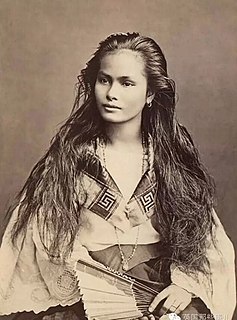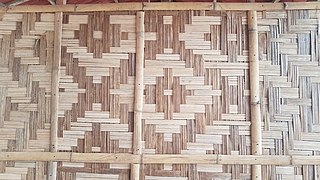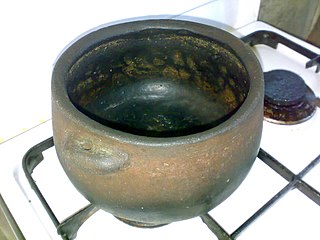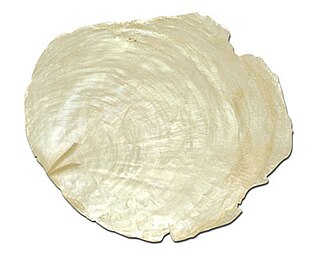 W
WAbacá, binomial name Musa textilis, is a species of banana native to the Philippines, grown as a commercial crop in the Philippines, Ecuador, and Costa Rica. The plant, also known as Manila hemp, has great economic importance, being harvested for its fiber, also called Manila hemp, extracted from the leaf-stems. Abacá is also the traditional source of lustrous fiber hand-loomed into various indigenous textiles in the Philippines like t'nalak, as well as colonial-era sheer luxury fabrics known as nipís. They are also the source of fibers for sinamáy, a loosely woven stiff material used for textiles as well as in traditional Philippine millinery.
 W
WAn abaniko is a type of hand fan from the Philippines.
 W
WAmakan, also known as sawali in the northern Philippines, is a type of traditional woven split-bamboo mats used as walls, paneling, or wall cladding in the Philippines. They are woven into various intricate traditional patterns, often resulting in repeating diagonal, zigzag, or diamond-like shapes. The term "sawali" is more properly defined as twilled weaving patterns. The term can also be applied to baskets and banig, which also use the same weaving patterns. Amakan panels are commonly confused with nipa walls, which are made from thatched leaves.
 W
WApir, also spelled aper, are traditional folding women's hand-held fans of the Maranao people of the Philippines. They are a part of the traditional dress of Maranao women. Royal bai (ladies) carry an apir in their right hand during ceremonies. A pair of apir fans are also commonly featured in Maranao traditional dances, including singkil and pagapir.
 W
WA barrel man or barrelman is a souvenir doll or statuette popular in the Philippines. The statuette usually consists of a crude male figurine carved out of wood, partially hidden inside a round wooden barrel. When the barrel is taken off, the male figure inside is revealed, sporting a prominent phallus in the lower part of the figure's anatomy.
 W
WThe buntal hat is a traditional straw hat from the Philippines woven from fibers extracted from the petioles of buri palm leaves. It is traditionally worn by farmers working in the fields and was a major export of the Philippines in the first half of the 20th century. It can also be paired with semi-formal barong tagalog as well as informal attire. Its main centers of production are Baliwag, Bulacan and (historically) Sariaya and Tayabas in Quezon Province. Buntal hats produced in Baliwag are also sometimes known as balibuntal hats, and are regarded as superior in quality to other types of buntal hats.
 W
WThe malong is a traditional Filipino rectangular or tube-like wraparound skirt bearing a variety of geometric or okir designs. The malong is traditionally used as a garment by both men and women of the numerous ethnic groups in the mainland Mindanao and parts of the Sulu Archipelago. They are wrapped around at waist or chest-height and secured by tucked ends, with belts of braided material or other pieces of cloth, or are knotted over one shoulder. They were traditionally hand-woven, with the patterns usually distinctive to a particular ethnic group. However, modern malong are usually machine-made or even imported, with patterns that mimic the traditional local designs.
 W
WA palayok is a clay pot used as the traditional food preparation container in the Philippines. Palayok is a Tagalog word; in other parts of the country, especially in the Visayas, it is called a kulon; smaller-sized pots are referred to as anglit. Neighboring Indonesia and Malaysia refer to such vessel as a periuk.
 W
WPamaypay, also known as paypay, payupas, buri fan, or anahaw fan, is a type of traditional hand-held fan from the Philippines. It is typically made from woven buri palm or anahaw palm leaves. It is usually heart-shaped, and woven in a technique known as sawali (twilled). The edges are braided and merges into a looped handle. It is also typically made into wall decorations and other handicrafts.
 W
WThe patadyong, is an indigenous Philippine rectangular or tube-like wraparound skirt worn by both men and women of the Visayas islands and the Sulu Archipelago, similar to the Malong, or Sarong. It was also historically worn in parts of Luzon like Pampanga and Sorsogon.
 W
WPhilippine ceramics refers to ceramic art and pottery designed or produced as a form of Philippine art.
 W
WPiña is a traditional Philippine fiber made from the leaves of the pineapple plant. Pineapples were widely cultivated in the Philippines since the 17th century for weaving lustrous lace-like luxury textiles known as nipis fabric. The name is derived from Spanish piña, meaning "pineapple".
 W
WSalakót is a traditional lightweight headgear from the Philippines used for protection against the sun and rain. They are usually dome-shaped or cone-shaped and can range in size from having very wide brims to being almost helmet-like. They are made from various materials including bamboo, rattan, nito ferns, and bottle gourd. The tip of the crown commonly has a spiked or knobbed finial made of metal or wood. It is held in place by an inner headband and a chinstrap. Salakot is also spelled as salacot in Spanish and salacco in French. It is the direct precursor to the pith helmet widely used by European military forces in the colonial era.
 W
WT'nalak, is a weaving tradition of the T'boli people of South Cotabato, Philippines. T'nalak cloth are woven from abacá fibers. The traditional female weavers are known as dream weavers, because the pattern of the t'nalak cloth are inspired by their dreams.
 W
WTapayan or tempayan are large wide-mouthed earthenware or stoneware jars found in various Austronesian cultures in island Southeast Asia. Their various functions include fermenting rice (tapai), fermenting vinegar or alcoholic beverages, storing food and water, cooking, and burial of the deceased.
 W
WTapis across various cultures in the Philippines may generally refer to a single, rectangular piece of cloth one wraps around oneself as clothing, but is also the term for a colorful, hand-woven wraparound skirt common in the pre-colonial period, and which is still used today as part of the María Clara gown and by culturally conservative tribes.
 W
WTipos del País, literally meaning Types of the Country, is a style of watercolor painting that shows the different types of inhabitants in the Philippines in their different native costumes that show their social status and occupation during colonial times.
 W
WThe windowpane oyster is a bivalve marine mollusk in the family of Placunidae. They are edible, but valued more for their shells. The shells have been used for thousands of years as a glass substitute because of their durability and translucence. More recently, they have been used in the manufacture of decorative items such as chandeliers and lampshades; in this use, the shell is known as the capiz or kapis. Capiz shells are also used as raw materials for glue, chalk and varnish.